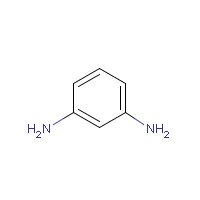m-Phenylenediamine
Agent Name
m-Phenylenediamine
CAS Number
108-45-2
Formula
C6-H8-N2
Major Category
Nitrogen Compounds

Synonyms
1,3-Diaminobenzene; 1,3-Phenylenediamine; 3-Aminoaniline; Benzene, 1,3-diamino-; C.I. Developer 11; CI Developer 11; Developer 11; Developer C; Developer H; Developer M; Direct Brown BR; Direct Brown GG; Metaphenylenediamine; m-Aminoaniline; m-Benzenediamine; m-Diaminobenzene; m-Fenylendiamin [Czech]; m-Phenylenediamine; meta-Aminoaniline; meta-Benzenediamine; meta-Diaminobenzene; UN1673; [ChemIDplus]
Category
Amines, Aromatic
Description
White crystals that change to red on exposure to light and air; [CHEMINFO]
Sources/Uses
Used to make diisocyanates for the production of polyurethane foams and other resins and polymers; Also used as a corrosion inhibitor, curing agent, photographic developer, and intermediate for other chemical products; [CHEMINFO] Used to make dyes, to develop dyes, to dye hair, and to cure epoxy resins; [ACGIH]
Comments
In acute studies at lethal doses (650 mg/kg), animals have tremors, convulsions, cyanosis, and methemoglobinemia. In subchronic studies, rats have increased liver weights. "Critical Effects" are irritation; liver; Confirmed Animal Carcinogen with Unknown Relevance to Humans; [ACGIH] Danger of skin sensitization; [MAK]
Biomedical References
Exposure Assessment
Skin Designation (ACGIH)
Insufficient data
TLV (ACGIH)
0.1 mg/m3
Vapor Pressure
0.0018 mm Hg
Explanatory Notes
Melting Point = 145-147 deg F; [CAMEO]
Adverse Effects
Skin Sensitizer
Yes
Methemoglobinemia
MetHgb is secondary toxic effect
Hepatotoxin
Hepatoxic (a) from occupational exposure (secondary effect) or (b) in animal studies or in humans after ingestion
IARC Carcinogen
Not classifiable
ACGIH Carcinogen
Not Classifiable
Diseases, Processes, and Activities Linked to This Agent
Diseases
Occupational diseases associated with exposure to this agent:
Processes
Industrial Processes with risk of exposure: